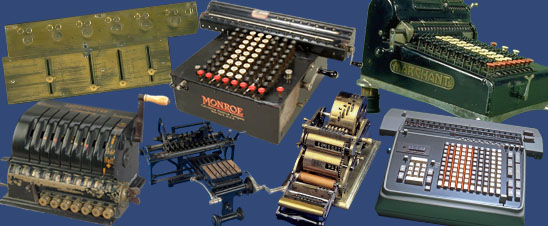Although the United States government had made use of computing devices at least from the 1850s, World War II brought unprecedented demands for calculations. These were met, in part, by large groups of people called computers, who used desk calculators like this one.
- Description
-
Although the United States government had made use of computing devices at least from the 1850s, World War II brought unprecedented demands for calculations. These were met, in part, by large groups of people called computers, who used desk calculators like this one. This particular machine was used at the Applied Physics Laboratory operated by Johns Hopkins University. When human computers were overwhelmed by the quantity of work that needed doing, new kinds of machines were invented .
-
This stepped drum machine has a metal frame painted gray, and eight columns of light green and blue-green plastic number keys, with a blank key of green plastic at the bottom of each column. These keys allow one to enter numbers of up to eight digits. Metal rods between the columns of keys turn to indicate decimal places.
-
On the right are two columns of function keys. The machine has no separate keys for multiplication. It has a key for cross tabulation.
-
Behind the number keys is a movable carriage with an nine-digit revolution register and a 17-digit result register. An arrow above the first column of keys assists in setting the carriage. Plastic buttons above the result register can be used to set up numbers. The carriage has sliding decimal markers for the two registers, as well as zeroing knobs on the right.
-
Marks on the sides and back of the machine read: FRIDEN. A mark visible through windows at the bottom front reads: D8-215775. A paper tag glued to the bottom reads: MODEL-D (/) FRIDEN CALCULATING MACHINE CO. INC. (/) MADE IN SAN LEANDRO, CALIFORNIA, U.S.A. (/) MANUFACTURED UNDER ONE OR MORE OF THE FOLLOWING U.S. PAT’S (/) DES. 103,425 2,229,889 2,229,890 2,229,895 2,229,901. A mark painted on the back reads: APL (/) 9601 (/) USN
-
References:
-
Ernie Jorgenson, Friden Age List, Office Machine Americana, Lewiston, Idaho p. 2.
-
"Carl Maurice Frederick Friden," National Cyclopaedia of American Biography, Clifton, N.J.: James T. White & Co., 54, 1973, pp. 7–8.
- Location
-
Currently not on view
- date made
-
1945
- maker
-
Friden Calculating Machine Company
- ID Number
-
MA.335427
- catalog number
-
335427
- accession number
-
319049
- maker number
-
D8 215775
